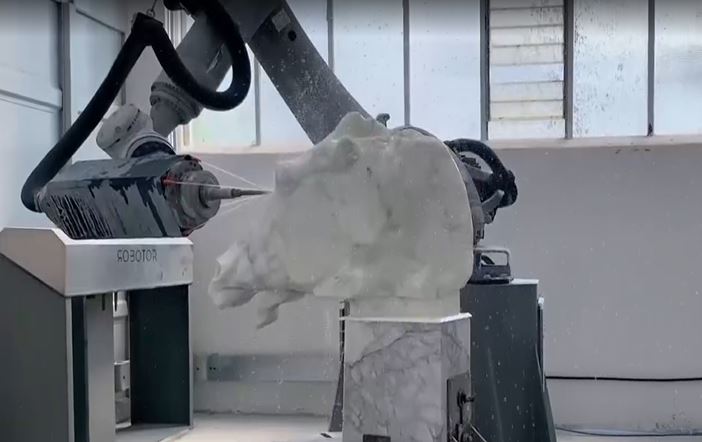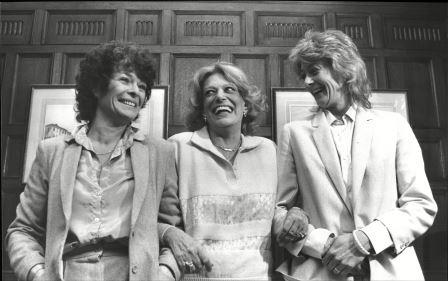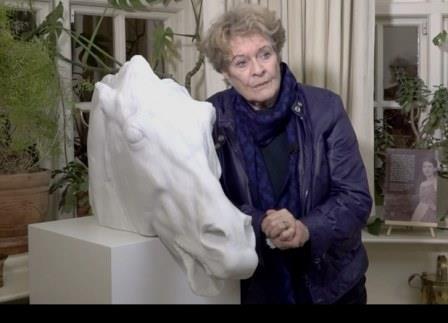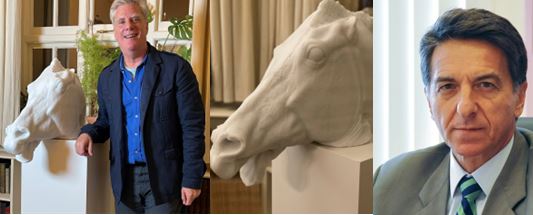The possible solution to Greece's long-standing request for the reunification of the Parthenon Sculptures from London may be held by... robots.
It is the first time in history that one of the Parthenon Sculptures in the British Museum has been replicated using digital 3D technology and a robot.
The famous chariot horse head of the goddess Selene: the ancient Greeks believed that a goddess Selene carried the moon across the sky each night. They imagined her driving a horse-drawn chariot with two white horses. Selene's crown lit up the moon as her white horses galloped across the night sky. And the horse's head in the British Museum is the exquisite sculpture carved by Pheidias in 5th century BC, and this year, 2022 digitally reproduced and carved by robotic 3D imaging machines.
The director and founder of the Institute of Digital Archaeology (IDA), Roger Michael described to ERT how they managed to scan the sculptures after the British Museum refused them permission.
"We asked the British Museum for permission to scan some of the items. We were surprised when they refused to give it to us, but we decided to take matters into our own hands and so we did the scans using portable equipment at the British Museum. We then converted these scans into a 3D model and from that 3D model, we then created this amazing marble sculpture carved from precious Pentelian marble," Roger Michael told ERT .
The Institute for Digital Archaeology (IDA) chose the head of a horse of Selene, which adorned the right end of the Parthenon's East pediment, as their first work of perfect reproduction.

“It's one of the most well-known works of the Parthenon Sculptures in the British Museum, and we chose it for that very reason, because one of the things we're trying to show with this installation is how great the technology is, how close to the original we can be with this reconstruction. Because it shows an animal reaching the limits of its effort, it's really an incredible sculpture," said Mr. Michael.
"It's chilling, this accuracy! I think it's great that we can feed information into a machine that makes a perfect copy of a work made by a human hand. The magic of it is amazing," Dame Janet Suzman, the Chair of the tells ERT.
Ms. Suzman, a multi-award winning actress was introduced to the plight of these sculptures, and the campaign by “ the tornado that was Melina Mercouri when she came here to the UK and swept us all along with her, she was a strong wind. And we were like autumn leaves falling and that's when I got excited," as she described her meeting with the culture Minister at the time.

Shuttershock image, user ID 361013921. Photo of Jane Suzman with Melina Mercouri and Vanessa Redgrave
The Institute for Digital Archaeology (IDA) is proposing to replace the Parthenon sculptures in the British Museum with exact replicas, something that covers the museum's argument as an educational institution and at the same time restores the Greeks' connection to their ancient heritage.
The debate has been intense in recent months about the Greek request, the people support it as shown by the opinion polls, and the Chair of the British Museum, George Osborne himself said that "an agreement is possible". But has the time for such an agreement arrived?
"Greeks love sculptures not only because they represent Greece in that part of history. Greece has many sculptures from the fifth century that do a much better job than these objects of representing this art. They love these works because of what they represent. They are part of their national pride, their heritage, for sentimental reasons, and that is why the originals must return to Greece. Britain needn't care about any of this. It's not their story. It is not their national heritage. It's not their national pride," Roger Michael told ERT.
Asked if she thought the British Museum would take up the idea, Dame Suzman replied: “ It's very imaginative at the moment. That seems to be the case. They haven't gotten there yet. But I think they will. Because they have to. They need to get their feet out of the mud. They are stuck in the mud. They are stuck."
"For 200 years, these things did their job, to awaken British academic, historical, social circles, and the awareness of the classical world was a huge resurgence of research and science , which these guys did," she says, pointing to sculpted replica of the horse's head.
"As my grandmother would say, enough already. They have to go home. They have to go." Dame Suzman stated categorically.

Roger Michael reveals to ERT that he spoke to the Chair of the British Museum, George Osborne in the summer and "there is no doubt that this will happen".
George Osborne has already told The Times "there is a deal that can be done".
The founder of the Digital Technology Institute said Greece's Ambassador, Ioannis Raptakis was speaking directly to Mr Osborne and he thought "negotiations are going very well."
Mr. Michael emphasized that, " in fact, I would not be surprised if when the Prime Minister of Greece comes to England next week he makes some very optimistic announcement. George Osborne is very clever. He is very successful. He's a politician, but he's also the publisher of a major newspaper, so he not only understands politics, but how to communicate politics. He is a man who cares about his heritage. He does not want to be the last who against the moral judgment of the whole world hangs from these things like grim death. He wants to be the man who finds a solution to a 200-year-old conflict and to be a hero, here in Britain but also in Greece, that's the person he wants to be. I guarantee you that's what I got from talking to him. And this is what I take from the knowledge of people who know him. But Ambassador Raptakis is exactly the same, a very pragmatic man but also a man who I think also cares about his legacy and would like nothing better than to be the man who negotiates an agreement ," Mr. Michael pointed out, noting that the problem may be the word to be used, however diplomacy is working in this direction and he thinks "we will hear some good news very soon."

Roger Michel of the Institute of Digital Archaeology (IDA), the 3D sculpted horse's head at the Freud Museum and Ambassador Ioannis Raptakis, Greece's Ambassador to the UK
ERT asked the British Museum about the new proposal and received the following answer:
”There are replicas of the British Museum Parthenon Sculptures in the Acropolis Museum, where they are displayed alongside the sculptures that remained in Athens. Our Greek colleagues from the Acropolis Museum have been to the British Museum in 2013 and 2017 to scan sculptures from the Parthenon."
The horse's head is on display at the Freud Museum in London. "The construction time of the copy was about two months, while it costed about 100 thousand euros" explained Alexi Karenovska, Director of Technology of the Institute of Digital Archaeology and added that "the next copy will be the depiction of the Battle of the Titans from the Metopian fragment of Parthenon, also in the British Museum."
The first exact copy of the Parthenon Sculptures, the Selene's horse head in the British Museum with the help of 3D digital technology took its place in history, reviving hope for the repatriation of the originals to the Acropolis Museum.
Interview by: Evdoxia Lymberi, to read the article online and watch the news bulletin, follow the link to ertnews.gr here.
All News from Greece and the World @ ertnews.gr